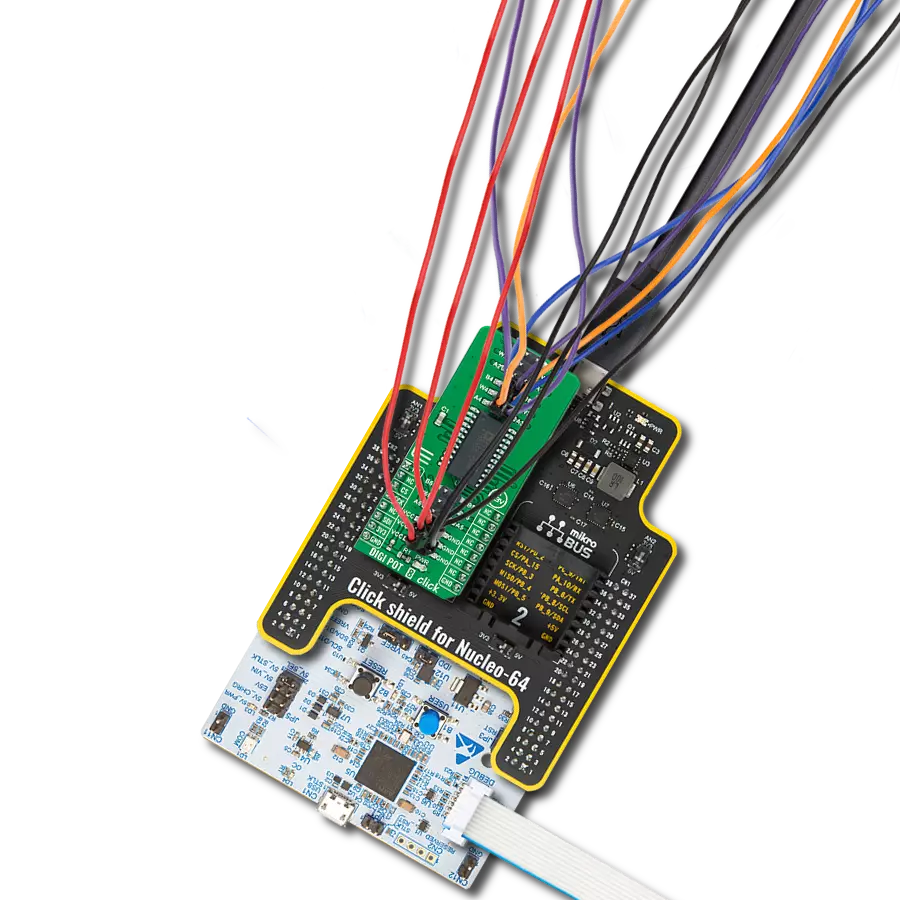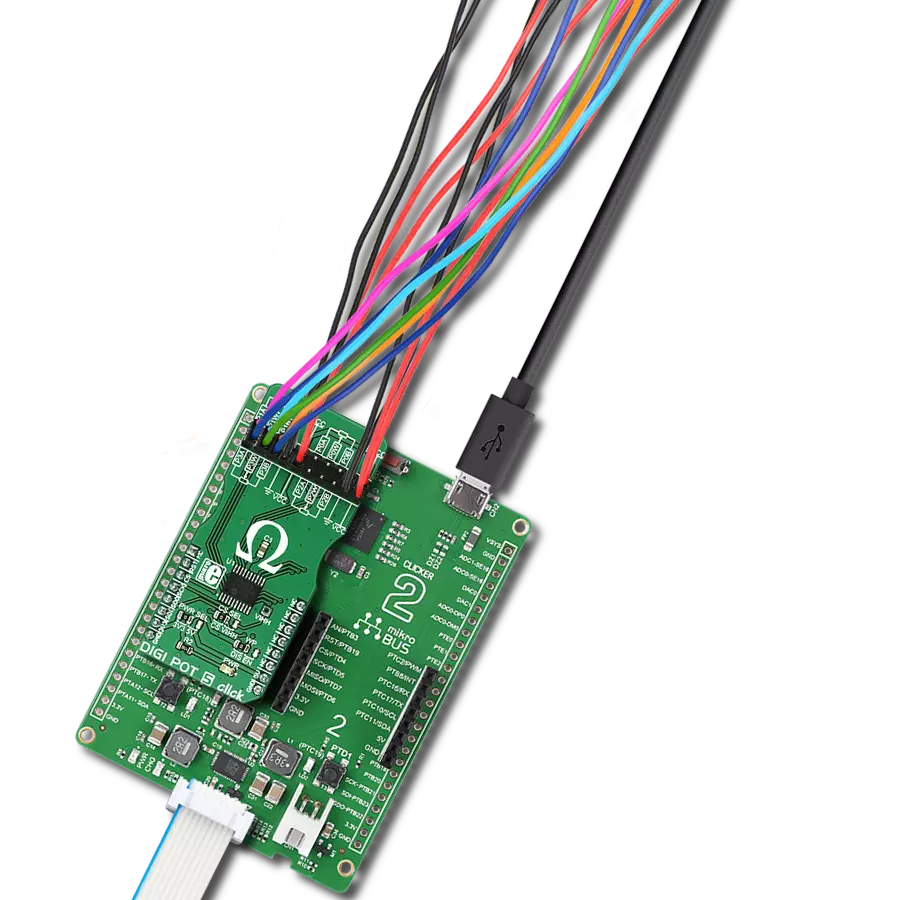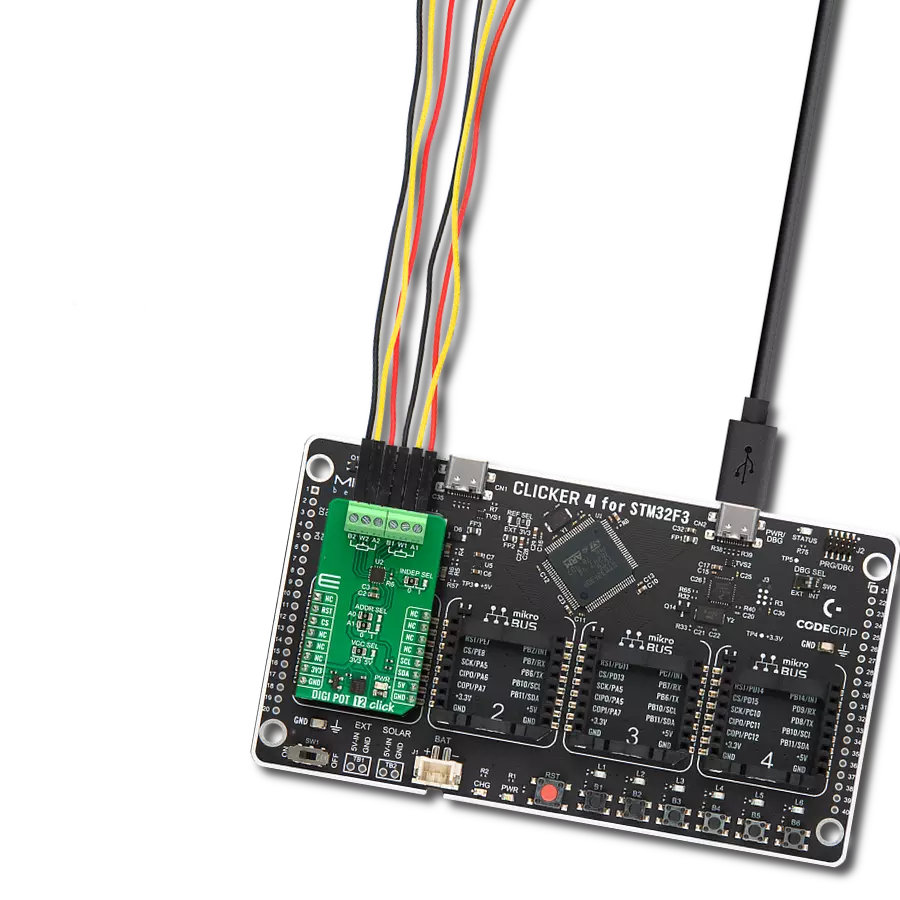Say goodbye to static resistance. Embrace dynamic control with our cutting-edge digital potentiometer.
A
A
Hardware Overview
How does it work?
DIGI POT 14 Click is based on the TPL0102, a dual-channel digital potentiometer with non-volatile memory from Texas Instruments. It is a two-channel linear-taper digital potentiometer. Each potentiometer can be used as a three-terminal potentiometer or a two-terminal rheostat. When the TPL0102 is powered down, it saves the last values of wipers in EEPROM, and when the power is restored, the positions of wipers are loaded to
their initial position. The TPL0102 features a fast power-up response time to wiper settings under 100μs, single-supply, and dual-supply operation ranges. DIGI POT 14 Click uses a standard 2-Wire I2C interface to communicate with the host MCU and supports Standard and Fast mode with up to 400kHz of clock frequency. The I2C address can be set over the ADDR SEL jumpers, where 0 is set by default. Both potentiometers' high, low, and wiper
pins are tied to screw terminals, properly labeled as A and B sides. This Click board™ can operate with either 3.3V or 5V logic voltage levels selected via the VCC SEL jumper. This way, both 3.3V and 5V capable MCUs can use the communication lines properly. Also, this Click board™ comes equipped with a library containing easy-to-use functions and an example code that can be used for further development.
Features overview
Development board
Nucleo 32 with STM32L432KC MCU board provides an affordable and flexible platform for experimenting with STM32 microcontrollers in 32-pin packages. Featuring Arduino™ Nano connectivity, it allows easy expansion with specialized shields, while being mbed-enabled for seamless integration with online resources. The
board includes an on-board ST-LINK/V2-1 debugger/programmer, supporting USB reenumeration with three interfaces: Virtual Com port, mass storage, and debug port. It offers a flexible power supply through either USB VBUS or an external source. Additionally, it includes three LEDs (LD1 for USB communication, LD2 for power,
and LD3 as a user LED) and a reset push button. The STM32 Nucleo-32 board is supported by various Integrated Development Environments (IDEs) such as IAR™, Keil®, and GCC-based IDEs like AC6 SW4STM32, making it a versatile tool for developers.
Microcontroller Overview
MCU Card / MCU

Architecture
ARM Cortex-M4
MCU Memory (KB)
256
Silicon Vendor
STMicroelectronics
Pin count
32
RAM (Bytes)
65536
You complete me!
Accessories
Click Shield for Nucleo-32 is the perfect way to expand your development board's functionalities with STM32 Nucleo-32 pinout. The Click Shield for Nucleo-32 provides two mikroBUS™ sockets to add any functionality from our ever-growing range of Click boards™. We are fully stocked with everything, from sensors and WiFi transceivers to motor control and audio amplifiers. The Click Shield for Nucleo-32 is compatible with the STM32 Nucleo-32 board, providing an affordable and flexible way for users to try out new ideas and quickly create prototypes with any STM32 microcontrollers, choosing from the various combinations of performance, power consumption, and features. The STM32 Nucleo-32 boards do not require any separate probe as they integrate the ST-LINK/V2-1 debugger/programmer and come with the STM32 comprehensive software HAL library and various packaged software examples. This development platform provides users with an effortless and common way to combine the STM32 Nucleo-32 footprint compatible board with their favorite Click boards™ in their upcoming projects.
Used MCU Pins
mikroBUS™ mapper
Take a closer look
Click board™ Schematic

Step by step
Project assembly
Software Support
Library Description
This library contains API for DIGI POT 14 Click driver.
Key functions:
digipot14_reg_write- DIGI POT 14 register write function.digipot14_set_pot_a_wiper- DIGI POT 14 set the wiper position of potentiometer A function.digipot14_set_pot_b_wiper- DIGI POT 14 set the wiper position of potentiometer B function.
Open Source
Code example
The complete application code and a ready-to-use project are available through the NECTO Studio Package Manager for direct installation in the NECTO Studio. The application code can also be found on the MIKROE GitHub account.
/*!
* @file main.c
* @brief DIGI POT 14 Click example
*
* # Description
* This library contains API for DIGI POT 14 Click driver.
* The demo application uses a digital potentiometer
* to change the resistance values.
*
* The demo application is composed of two sections :
*
* ## Application Init
* The initialization of I2C module, log UART, and additional pins.
* After the driver init, the app executes a default configuration.
*
* ## Application Task
* This example demonstrates the use of the DIGI POT 14 Click board™.
* The demo application iterates through the entire wiper range..
* Results are being sent to the UART Terminal, where you can track their changes.
*
* @author Stefan Ilic
*
*/
#include "board.h"
#include "log.h"
#include "digipot14.h"
static digipot14_t digipot14;
static log_t logger;
void application_init ( void )
{
log_cfg_t log_cfg; /**< Logger config object. */
digipot14_cfg_t digipot14_cfg; /**< Click config object. */
/**
* Logger initialization.
* Default baud rate: 115200
* Default log level: LOG_LEVEL_DEBUG
* @note If USB_UART_RX and USB_UART_TX
* are defined as HAL_PIN_NC, you will
* need to define them manually for log to work.
* See @b LOG_MAP_USB_UART macro definition for detailed explanation.
*/
LOG_MAP_USB_UART( log_cfg );
log_init( &logger, &log_cfg );
log_info( &logger, " Application Init " );
// Click initialization.
digipot14_cfg_setup( &digipot14_cfg );
DIGIPOT14_MAP_MIKROBUS( digipot14_cfg, MIKROBUS_1 );
if ( I2C_MASTER_ERROR == digipot14_init( &digipot14, &digipot14_cfg ) )
{
log_error( &logger, " Communication init." );
for ( ; ; );
}
if ( DIGIPOT14_ERROR == digipot14_default_cfg ( &digipot14 ) )
{
log_error( &logger, " Default configuration." );
for ( ; ; );
}
log_info( &logger, " Application Task " );
}
void application_task ( void )
{
for ( uint8_t wiper_val = DIGIPOT14_MIN_POSITION; wiper_val <= DIGIPOT14_MAX_POSITION; wiper_val++ )
{
digipot14_set_pot_a_wiper( &digipot14, wiper_val );
digipot14_set_pot_b_wiper( &digipot14, wiper_val );
log_printf( &logger, " Resistance = %.3f KOhm \r\n",
( DIGIPOT14_MAX_RESISTANCE_KOHM * ( wiper_val / DIGIPOT14_MAX_POSITION_NUM ) ) );
Delay_ms ( 1000 );
}
}
int main ( void )
{
/* Do not remove this line or clock might not be set correctly. */
#ifdef PREINIT_SUPPORTED
preinit();
#endif
application_init( );
for ( ; ; )
{
application_task( );
}
return 0;
}
// ------------------------------------------------------------------------ END
Additional Support
Resources
Category:Digital potentiometer



































